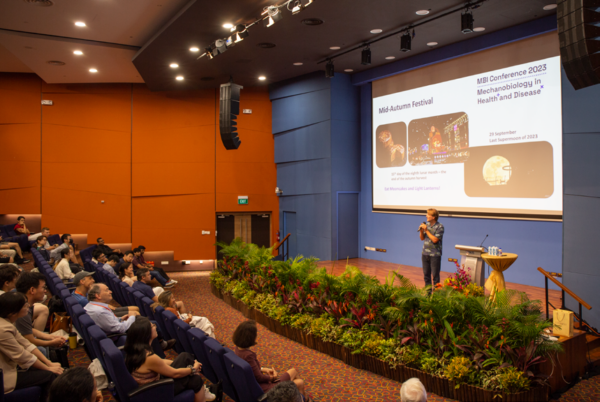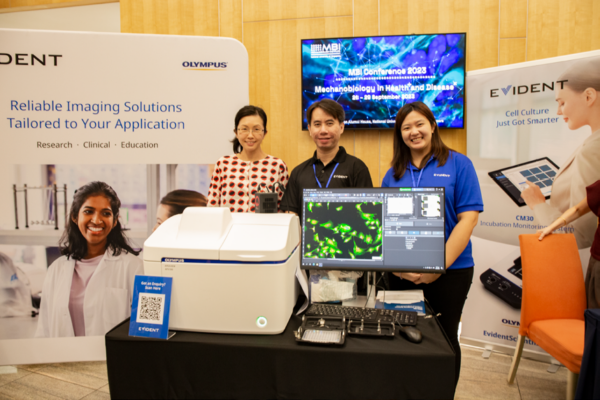MBICONF2023: Over 250 convene for MBI’s biggest in-person meeting exploring the latest in mechanobiology
After a long year of planning and months of anticipation, MBI Conference 2023: Mechanobiology in Health and Disease was brought to realization from 26 – 29 Sep 2023. A coalescence of more than 250 probing minds joining forces from 21 countries, each carried with them exciting discoveries from years of research in mechanobiology or associated domains. Through a series of invited, short and flash talks, with poster presentations and spontaneous discussions, the Shaw Foundation Alumni House became the site of active diffusion of knowledge and inquiry during the conference.
The conference commenced with an opening address by MBI’s Director, Prof. Rong Li, who welcomed all the eager researchers in attendance, recounted the early history of MBI and highlighted the importance of approaching health and disease through a mechanical perspective. Through 7 sessions, the conferences covered 5 central themes of Tissue Organization/Mechanics, Nuclear/Cytomechanics, Cell Division and Differentiation, ECM Mechanobiology and Mechano-Technologies, reflecting the wide diversity of scales, processes and applications of mechanobiology relating to the human physical condition.
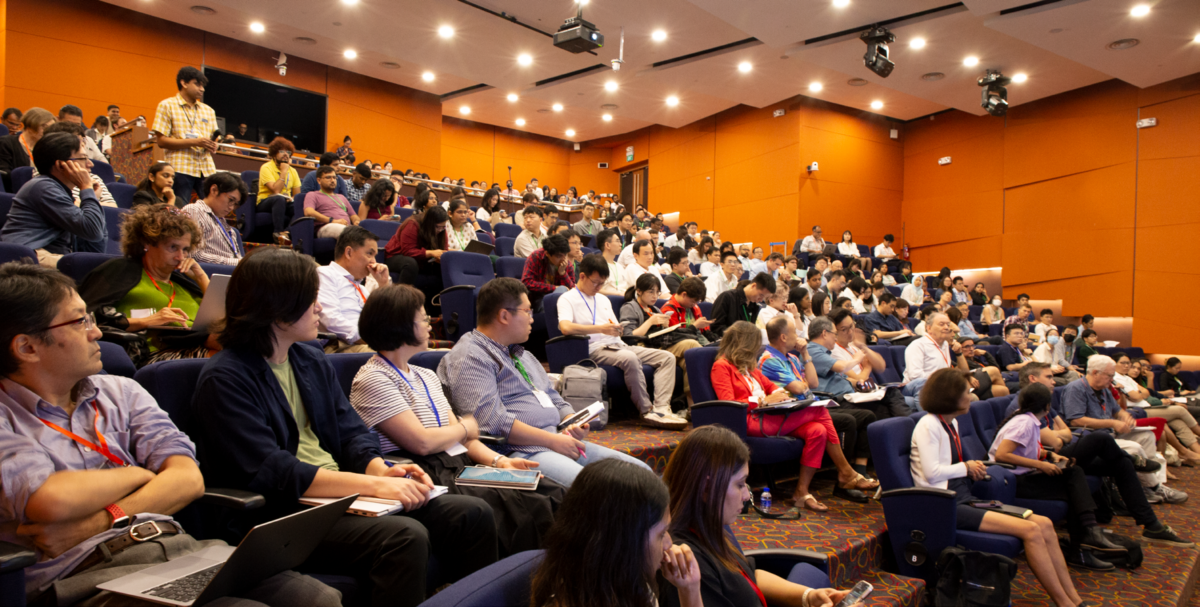
Starting off from an more macro point-of-view, Sessions I and II focused on Tissue Organization and Mechanics. The talks covered new revelations on the Mechanical control of epithelial homeostasis and cancer, Mechanobiology of apoptotic cell extrusion and clearance, Hydrostatic regulation of vessel sprouting, Mediation of aberrant mechanoresponses in antherosclerosis, Global control of immune cell physiology via membrane tension, Compression-enabled mechanical bi-stability in epithelial folding, Capillary confinement and flow on cancer cell motility, Protein aggregates-induced stiffness as basis for Huntington’s disorder, Mechanical control of theca cells during folliculogenesis and Regulation of protein localization by actin cortex.
The talks also revealed inventions of new models and technologies to aid in discovery, including In utero manipulation of mechanobiology genetics, Nanostructures for transepithelial drug delivery, Recapitulation of tissue patterning differentiation in 3D models, Gut-microbiome-on-chip to study organization of gut microbiota, Advanced imaging with thermal-sensory probes, and Biophysical model for ovarian follicle growth.
Zooming further into the cell, Sessions III and IV concentrated deeper on Nuclear and Cytomechanics. The talks covered novel insights into Actin architecture and maintenance of its dynamic steady state, Neuron connections with tunneling nanotubes, Focal adhesion/actomyosin cytoskeleton/microtubule network crosstalk, Fibrillar adhesions mechanics and functions, Mechanosignalling and cell junction maintenance in endothelial cells, Mechanical shielding of nucleus during force transmission, Synchronization of cell migration signaling pathways with BNIP, Drug delivery using ultrasound and microbubbles for gene therapy, Defining the graded mechanical activation of GPCRs, Force-dependent structural changes of Filamin C, Liquid-liquid phase-separation driven insulin-IGF signaling, Deer antler regeneration from active proliferation and induced tension, ERK-mediated mechanical feedback for tissue patterning via cell competition and Microtubule mechanoadaptation for cell survival in confined spaces.
Then it was time to look towards the cell cycle in Session V, which revolved around Cell Division and Differentiation. The talks covered the latest discoveries on Dynamic cellular projections as sensors of tissue damage, Cell niche control with mulitphoton microfabrication and micropatterning platform, Cellular responses to long-term hypo-osmotic stress, Macromolecules’ and counterions’ effects on hypo-osmotic stress adaptation, Symmetry breaking of kidney organoids using morphogen gradients, Regulation of cytoplasmic actin and mitosis by cadherin, P-caderin regulation of cytoplasmic and mitotic spindle actin, Dynamics of epithelial junction formation and compartmentalization and Mechanical homeostasis by laminins for retinal function.
Bringing out our attention towards the cell exterior, Session VI had us fixated on ECM Mechanobiology. The talks covered the most current findings surrounding the Stretching of ECM proteins to induce mechanochemical switch-like behvaiors, Identifying contributors to cardiac aging with dynamic ECM hydrogel system, Defining roles of ECM in cardiac fibroblast activation with hybrid scaffolds, Curved nanofiber network-induced cellular bridge formation, Mechanosensing of spheroids in a linear stiffness gradient platform, Determination of stem cell fates from stiffness inputs into mechanosensor EGR1, Role of LINC complex proteins in formation of skin, Collective invasion of basement membrane by expansion and contractility and Manipulation of tumor cell mechanics drives malignancy.
Finally, we transit to real-world applications in Session VII, featuring Mechano-Technologies. The talks introduced new methodologies and technologies such as Binder/tag biosensors to visualize stretching of adhesion proteins, Engineering anti-cancer therapies via a mechanoceutical approach, Manipulating microchannels parameters to control stem cell fates, Using confinement to suppress force-induced cancer cell killing, Single-molecule imaging for visualization of bacterial cytoskeleton dynamic, Adopting a “Cell as a Machine” approach to model NASH for dug testing, Utilizing varied-shaped micropatterns to find effect of cell rheology on adherens junction and Reversible shearing DNA-based tension probes to measure forces in macrophages.
![]()
![]()
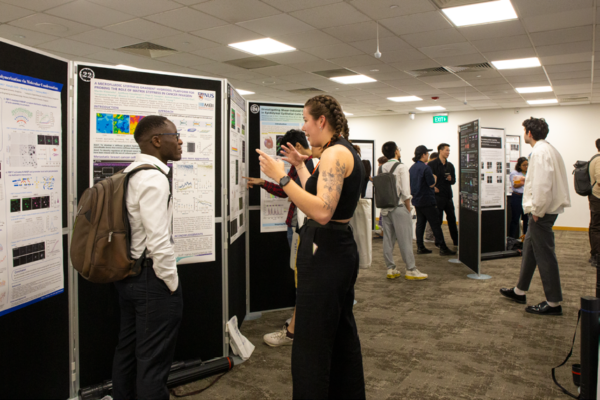
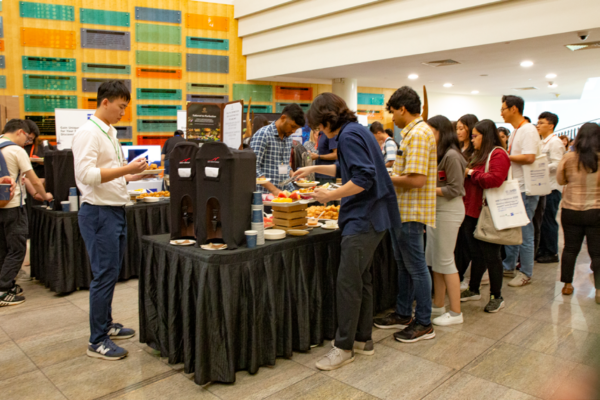
Following the invited talks from the illustrious mechanobiology heavyweights, the flash talks segment gave the lime-light to bright, budding scientists, who were specially picked for their research potential and awarded the Travel Awards graciously sponsored by Paeonia Foundation. The awardees went in rapid succession after another and each made a quickfire, yet thrilling, presentation of their projects.
The ongoing circulation of information was sustained via various Q&A segments and poster presentation-plus-networking sessions, where there were more than a hundred posters presented, which cued for more diverse and intimate discussions. Huge congratulations were due for Li Yixuan, Simran Rawal, Roman Fedoryshchak and Wang HaiYang, as they clinched the coveted Poster Awards among many others.
To keep up all the hustle and bustle, the conference was fueled by timely tea breaks and scrumptious buffet spreads. Most impressively, a stunning banquet was organized at the ballroom of NUSS Kent Ridge Guild House in the evening of Day 2, livened up with fun quizzes, free-flowing conversations and alcohol, downing the room in a warm, buzzy atmosphere.
Coincidentally, the conference concluded on the same day of the Mid-Autumn Festival. To commemorate the event, some of the attendees spent their evening coasting along on a ride on the Singapore River Cruise, admiring the lights and music from the crowded bars along the Quay and basking in the gentle glow of the full moon above.
The fervent participation of the attendees was what ensured the result of a successful conference, which received many, highly positive feedback. This was also a prime opportunity for many to stand witness to our MBI peers taking the podium, poster stands and audiences by storm, and did magnificently in presenting their research under the sharp lens of other experts.
An extremely huge thank you to our presenters, sponsors (Paeonia Foundation, Zeiss, Evident, Novogene, Re-Stem Biotech and Company of Biologists), scientific organizers, session chairs, poster judges, conference secretariat, volunteers and everyone else who conferred their support to the conference, as well as all the attendees who brought their collective specialized knowledge, intellectual rigor and unbounded enthusiasm to the conference. This is the first inaugural in-person-and-international scientific meeting MBI has hosted in five years due to the pandemic. With this successful kickoff, MBI will continue to keep the ball rolling with more to come in the future.
